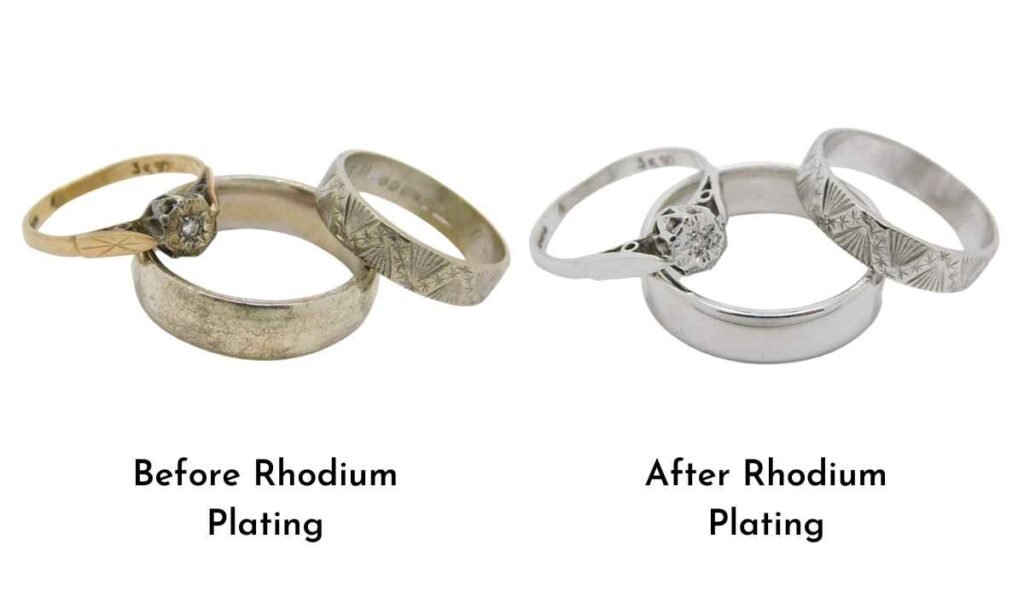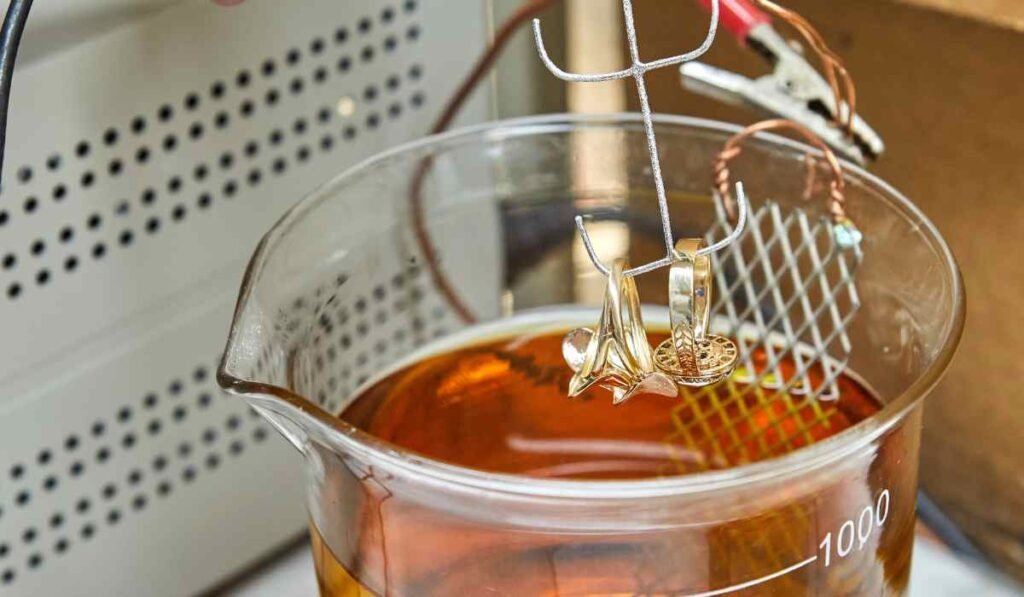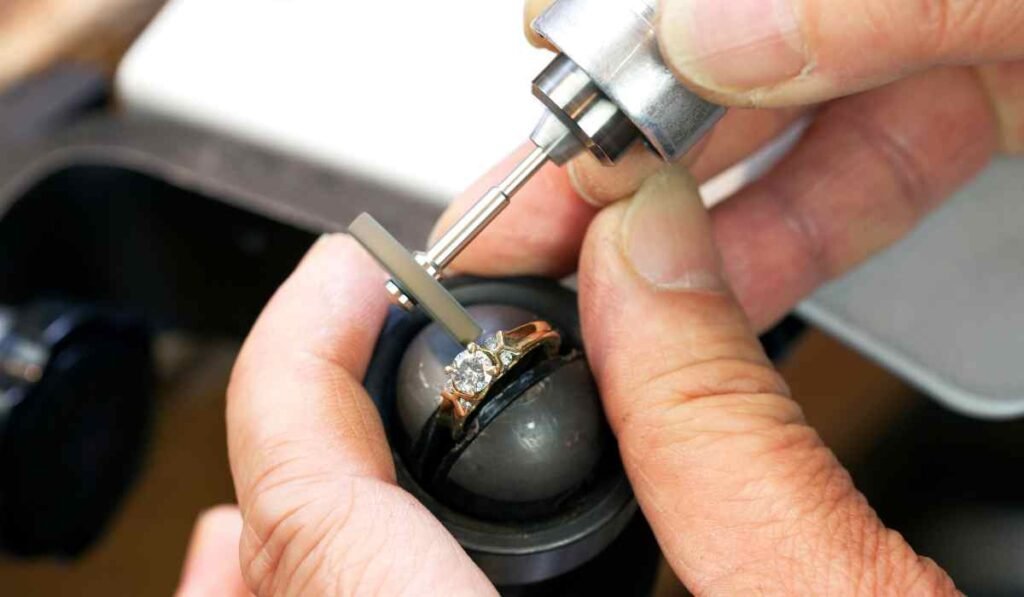Ever thought about making your jewelry extra shiny to make it look super fancy? Well, there’s a cool trick in the jewelry world called rhodium plating. It’s not just about adding shine; it’s like magic that makes your favorite pieces look even more awesome. In this article, we will be looking deep into rhodium plating, from its chemical processes to the benefits it brings to your cherished accessories.
Table of Contents
ToggleWhat is rhodium?
Rhodium is a precious metal often used in the world of jewelry to make pieces look extra special. It’s like a secret ingredient that gives jewelry a brilliant shine and a touch of elegance. Rhodium is applied as a thin layer on items like rings or necklaces through a process called rhodium plating.
This not only enhances the beauty of the jewelry but also provides extra protection against wear and tear. So, when you hear about rhodium, think of it as the magic that makes your favorite pieces sparkle and stand out.
What is rhodium plating?
Rhodium plating involves coating jewelry with a thin layer of rhodium, a rare and precious metal. Known for its dazzling white color, rhodium provides a brilliant finish, transforming ordinary pieces into extraordinary works of art.
Rhodium plating involves a chemical process where a thin layer of rhodium is electroplated onto the surface of jewelry. This not only enhances the appearance but also adds a layer of protection against wear and tear. Rhodium is favored for its durability and resistance to scratches, making it an ideal choice for jewelry finishing.

Properties of Rhodium Plating
Rhodium plating is prized for its impressive properties, including exceptional durability and scratch resistance, making it a reliable choice for preserving the longevity of jewelry. Here are some of the aspects for which rhodium plating is known:
1. Durability and Scratch Resistance
Rhodium-plated jewelry boasts increased durability, protecting it from scratches and external damage. This process significantly prolongs the lifespan of your favorite pieces.
2. Enhanced Aesthetic Appeal
The reflective nature of rhodium enhances the overall aesthetic, providing a mirror-like finish that elevates the appearance of any accessory.
3. Protection Against Tarnishing
Rhodium creates a barrier that shields jewelry from tarnishing, ensuring your pieces maintain their brilliance over time.
4. Hypoallergenic Property
Rhodium-plated jewelry is an excellent choice for those with sensitive skin, as it’s hypoallergenic.
Pros & Cons of Rhodium Plating
Rhodium plating has advantages such as improved aesthetics, scratch resistance, and protection against tarnishing. However, it also has drawbacks, including the need for periodic reapplication, potential expense, and the temporary nature of the treatment.
Pros of Rhodium Plating
- Enhances Appearance
- Provides Increased Shine
- Offers Scratch Resistance
- Protects Against Tarnishing
- Hypoallergenic Properties
Cons of Rhodium Plating
- Limited Durability
- Can be Expensive
- Requires Regular Maintenance
- Not a Permanent Solution
- Thickness and Uniformity Issues

Rhodium vs Gold vs Platinum Comparison
Rhodium, gold, and platinum are all precious metals used in jewelry, each with its own set of characteristics and appeal. Let’s explore the differences between rhodium, gold, and platinum:
| Characteristics | Rhodium | Gold | Platinum |
|---|---|---|---|
| Primary Use | Plating material, often applied over other metals like white gold or silver | Standalone metal, commonly alloyed with copper or silver | Standalone metal, used in its pure form for jewelry |
| Color | Bright, reflective finish, enhances the appearance of underlying metals | Warm yellow hues, can be alloyed for various shades | Natural white luster, cool-toned metal |
| Durability | Highly durable and resistant to tarnish, but the plating layer may wear off over time | Varies with karatage. Lower karat gold is more resilient; higher karat gold is softer | Exceptionally durable and resistant to tarnish, heavier and more robust than gold |
| Cost | Cost-effective, as it is often used as a plating material | Prices vary based on karatage; 24k gold is more expensive than lower karat options | Generally more expensive than gold due to rarity and density |
| Maintenance | Periodic reapplication may be needed to maintain the initial brilliance | Requires regular cleaning to remove dirt and oils, but durable for everyday wear | Minimal maintenance; retains its luster without tarnishing |
| Weight | Lightweight due to its plating nature | Varies based on karate; higher-karat gold is softer and lighter | Heavier and denser than gold, providing a substantial feel |
| Allergenic | Generally hypoallergenic | Can cause allergies in some individuals, especially with higher-karat gold | Hypoallergenic; suitable for those with sensitive skin |
| Suitability | Ideal for plating over other metals, enhancing their appearance | Versatile for a wide range of jewelry styles, it is often chosen for engagement rings | Suitable for intricate designs, it is often chosen for its enduring strength and sophisticated appearance |
Rhodium Plating vs. Cleaning: What’s the Difference?
As we mentioned before rhodium plating is like giving your jewelry a makeover. It adds an extra layer of shine and protection, enhancing its overall appearance and durability. On the other hand, regular cleaning involves removing dirt, oils, and other build-ups from the surface.
While rhodium plating provides a long-lasting shine and safeguards against tarnishing, it doesn’t eliminate the need for cleaning. Cleaning is essential for addressing everyday wear and tear, ensuring your jewelry stays radiant.
Maintenance of Rhodium-Plated Jewelry
Just like any precious treasure, rhodium-plated jewelry deserves special care. To ensure your favorite pieces continue to shine bright for years to come, it’s essential to follow some dos and don’ts. Here are the key guidelines for maintaining the beauty of your rhodium-plated jewelry:
Dos:
- Gentle Cleaning: Use a soft cloth to clean your jewelry and avoid abrasive materials.
- Storage: Store your rhodium-plated pieces in a cool, dry place, away from direct sunlight.
- Regular Inspections: Check for any signs of wear or damage and address them promptly.
- Professional Cleaning: Periodically, seek professional cleaning to maintain the brilliance of your jewelry.
- Wear Mindfully: Put on your jewelry after applying makeup, lotions, or perfumes to prevent chemical reactions.
Don’ts:
- Avoid Harsh Chemicals: Keep your rhodium-plated jewelry away from harsh chemicals, as they can damage the plating.
- No Swimming or Showering: Remove your jewelry before swimming or showering to prevent exposure to chlorine and soap.
- Avoid Scratching: Be cautious to prevent scratches, as they can compromise the rhodium plating.
- No Heavy-Duty Cleaning: Refrain from using strong cleaning solutions or ultrasonic cleaners.

Here are some of the commonly asked questions about Rhodium
What is Black Rhodium?
Black rhodium plating is a unique jewelry finishing technique that involves applying a thin layer of black rhodium to metal surfaces. This process imparts a striking and dark appearance to the jewelry, adding a touch of drama and contemporary elegance. Black rhodium-plated pieces are increasingly popular for those seeking a bold and distinctive aesthetic in their accessories.
What is the average cost of rhodium plating?
The cost of rhodium plating can vary depending on several factors, including the piece of jewelry, the jeweler’s expertise, and the current market price of rhodium. On average, rhodium plating for a piece like a ring or necklace may range from $50 to $200.
Keep in mind that this is a general estimate, and prices can differ based on individual jewelers and specific jewelry items. It’s advisable to consult with a jeweler for a more accurate cost based on your particular piece and location.
Which is better sterling silver or rhodium plated?
It depends on personal preference. Sterling silver is a precious metal in its own right, while rhodium-plated jewelry, often applied to sterling silver, enhances durability and provides a shiny finish. Choose based on your style preferences and desired level of maintenance.
How often should I get my jewelry replated with rhodium?
To keep that unparalleled shine, consider replating every 12–18 months, depending on wear and tear.
How long does rhodium plating last?
The duration of rhodium plating varies, but it typically lasts for several months to a few years, depending on factors like wear, care, and the thickness of the plating. Regular maintenance may be needed to preserve the shine over time.
Can I clean my rhodium-plated jewelry with regular jewelry cleaners?
Yes, but with caution. Opt for mild cleaners to avoid damaging the rhodium layer.
Does rhodium plating make my jewelry hypoallergenic?
While it adds a layer of protection, it’s essential to know the base metal. If you have metal allergies, choose wisely.
Can I resize rhodium plated rings?
Resizing is possible, but it requires expertise. Consult a professional jeweler to avoid damaging the rhodium finish.

Is rhodium plating suitable for all types of jewelry?
While commonly used on white gold and silver, rhodium plating may not be suitable for jewelry with gemstones that are sensitive to high temperatures.
How should rhodium-plated jewelry be cared for?
Clean gently with a soft cloth and avoid abrasive cleaners to maintain its shine. Follow our maintenance guide mentioned above.
Is rhodium plated jewelry good?
Yes, rhodium-plated jewelry is an excellent choice. It enhances the appearance, adds durability by resisting scratches and tarnish, and is particularly beneficial for white gold and silver pieces.
Conclusion
Rhodium plating is not merely a surface treatment; it’s a commitment to lasting radiance. From its chemical composition to its transformative impact on aesthetics, rhodium stands as a testament to the union of science and art in the world of jewelry. Consider this process to revitalize your favorite pieces and enjoy the lasting brilliance of rhodium.
